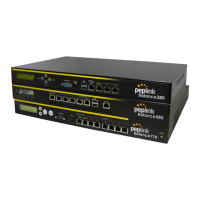
Do you have a question about the peplink 210 and is the answer not in the manual?
| Brand | peplink |
|---|---|
| Model | 210 |
| Category | Wireless Router |
| Language | English |
Lists and describes the various network features supported by the Peplink Balance.
Covers additional features beyond core network support, such as remote management.
Specifies the package contents for the Peplink Balance 210 and 310 models.
Lists the package contents for the Peplink Balance 380, 390, 580, 710, and 1350 models.
Details the Peplink Balance 210 model, including appearance and LED indicators.
Details the Peplink Balance 310 model, including appearance and LED indicators.
Details the Peplink Balance 380/390 models, including appearance, LEDs, and LCD.
Details the Peplink Balance 580 model, including appearance, LEDs, and LCD.
Details the Peplink Balance 710 model, including appearance, LEDs, and LCD.
Details the Peplink Balance 1350 model, including appearance, LEDs, and LCD.
Lists the necessary items and prerequisites before installing the Peplink Balance.
Provides step-by-step instructions for connecting the Peplink Balance to the network.
Explains how to configure LAN and WAN settings for optimal network operation.
Details how to access and log in to the Peplink Balance's web-based administration interface.
Guides users through initial WAN connection setup using the device's setup wizard.
Covers advanced network configuration options, referring to specific sections.
Covers DHCP, Static IP, PPPoE, GRE, and Mobile Internet connection types.
Configures periodic checks to ensure WAN connections are healthy and operational.
Monitors and tracks network usage, with options for notification and disconnection.
Enables association of dynamic WAN IP addresses with host names for remote access.
Covers the configuration of Site-to-Site VPN connections, including peer details and encryption.
Explains how to establish VPN connections when the device is behind a NAT router.
Displays the current status of established Site-to-Site VPN connections.
Defines policies for managing outbound traffic, including application compatibility and custom rules.
Enables creation of custom rules to manage outbound traffic behavior and load distribution.
Specifies internal servers and their IP addresses for inbound access configuration.
Defines inbound services, mapping external requests to internal servers and ports.
Enables automatic inbound port forwarding for UPnP and NAT-PMP compliant devices.
Configures DNS records to facilitate inbound load balancing and domain name resolution.
Categorizes LAN and PPTP clients into user groups for policy application.
Defines minimum bandwidth reservation for user groups during peak load.
Sets priority levels for different applications to ensure optimal performance.
Configures rules for filtering traffic in both outbound and inbound directions.
Enables detection and prevention of network intrusions and Denial-of-Service attacks.
Configures redundancy and failover between two Peplink Balance units for continuous operation.
Enables a built-in PPTP server for remote access to the local network.
Manages forwarding of specific network services like SMTP, Web Proxy, and DNS.
Supports specific Internet services like SIP, FTP, TFTP, and IPsec NAT-T through the device.
Configures user accounts, passwords, and access settings for the web administration interface.
Details the process for upgrading the Peplink Balance's firmware online or via a manual file upload.
Tests network connectivity by sending ICMP echo requests to specified interfaces.
Traces the routing path of network packets to a destination through a specific interface.
Shows device information such as router name, model, firmware, and MAC addresses.
Displays active inbound and outbound network sessions on each WAN connection.
Lists events that have occurred on the Peplink Balance, with options to refresh or clear the log.
Displays bandwidth usage statistics for WAN connections.
Details how routing works in NAT mode, including IP packet translation and security benefits.
Explains routing in IP Forwarding mode, where IP addresses remain unchanged.
Demonstrates optimizing performance by configuring WAN load balancing for different services.
Ensures session stability for IP-sensitive websites by maintaining a consistent WAN IP address.
Configures inbound NAT mappings to allow remote access to specific hosts on the LAN.
Sets up firewall rules to restrict inbound access, enhancing network security.
Sets up outbound firewall rules to restrict LAN user access, e.g., disallowing FTP.
Details routing, WAN support, device management, security, and physical interfaces.
Lists specifications for Peplink Balance 380/390: routing, WAN, management, security, and interfaces.
Details specifications for Peplink Balance 580: routing, WAN, management, security, and interfaces.
Lists specifications for Peplink Balance 710: routing, WAN, management, security, and interfaces.
Details specifications for Peplink Balance 1350: routing, WAN, management, security, and interfaces.
